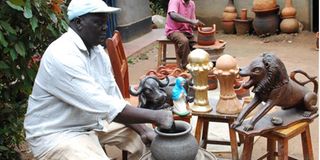Pottery transforming lives in Kakamega

Jacob Mate Shamwama working on his pots at Ilesi in Kakamega County. PHOTO | ISAAC WALE |
What you need to know:
- Residents of Ilesi village reap rewards as people flock to the area.
- The tradition of pottery has a strong place in the community.
Ilesi village in Kakamega East district has carved a niche for itself as the home of fine pottery making in western Kenya.
The village is located about six kilometres from Kakamega town along the busy Kakamega-Kisumu highway.
Motorists driving along the road will not fail to catch a glimpse of the assorted pottery: different designs and sizes of cooking pots, flower vases and all manner of earthen ware made from clay.
The demand for earthenware to decorate homes has opened new opportunities for villagers to transform their lives by selling the pottery to earn an income.
Villagers have embraced the art of making pots, bowls, flower vases and other wares from moist clay as a means to earn a livelihood, besides engaging in subsistence farming.
Pottery may sound mundane for the sophisticated and those who have embraced the modern way of life but the pastime has left a smile on the faces of many families in Ilesi village.
The legendary Crying Stone locally known as Ikhongo murwi is also located opposite the vibrant pottery market on the road.
Tourists and others visitors to western Kenya cannot resist the temptation to stop at Ilesi to sample the different wares.
The demand for the products in neighbouring Uganda and Tanzania has triggered a frenzy of activity among villagers who want to exploit the opportunity to turn around their economic fortunes.
The villagers spent much of their time working on the clay brought in from distant swampy places to make the traditional water pots used for cooking meals and storing water for drinking as well as other domestic uses.
STRONG PLACE
Among the Isukha and Idakho sub-tribes of the Luhya community, the Abashitaoand Basaka clans are renowned for their mastery of pottery.
The tradition of pottery has a strong place in the community and those distinguished in the art are highly regarded for the contribution they make to preserve and promote the activity.
A small cooking pot is sold at Sh100 while a flower vase costs between Sh300 and Sh600. The cheapest energy saving stoves made from the special type of clay are sold for Sh200.
An elder, Jacob Mate Shiamwama, started practicing pottery in 1963 and has never looked back.
Today, Mzee Shiamwama, a respected craftsmen, has managed to build himself a permanent house connected to electricity.
Four of his children, two sons and two daughters, have completed their secondary education and are taking up further training in college from the earnings he has made from pottery.
“I decided to learn the craft after dropping out of school in 1963 and I do not regret making the decision since what I earn has transformed my life,” said Mzee Shiamwama.
He said his customers drove from different parts of the country place their orders for wares.
The growing demand has made his son join him so they are able to deliver in time and decorate the pots and bowls to enhance their beauty.
Mzee Shiamwama, who learnt the craft from his late grandfather, said his wares had found their way to markets in Central Kenya, Nairobi and Mombasa.
Buyers were also coming in from Kampala and Dar es Salaam because of the special way they are made and decorated.
His son, Godfrey Itambe, has opted to join his father in making pots after completing his secondary education and taking up a project management course at the Kenya Institute of Management.
“I’m happier working on the project with my father since what we make has made our lives brighter,” he said.





